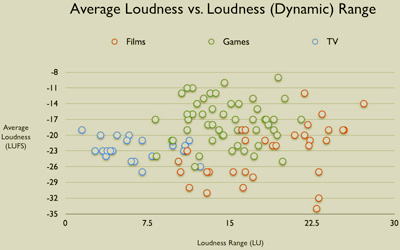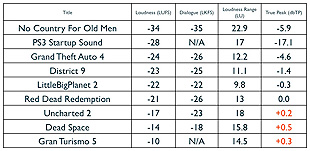 The attitude to audio taken by TV advertisers and gamers could not be more contrasting, more telling – or more damning.
The attitude to audio taken by TV advertisers and gamers could not be more contrasting, more telling – or more damning.
While advertisers eagerly lay claim to the term ‘creative’, their antagonistic stance on loudness betrays a small-minded regard for sound and its applications. Gamers, on the other hand, appear to be getting the most out of audio on all fronts. And that includes loudness…
Having taken issue with the antagonistic attitude adopted by many advertisers in pursuit of our custom in a Fast-and-Wide recent blog, a couple of further loudness discussions have provided more food for thought. The first was a session at the UK Develop (game developers’) conference, which revealed some refreshingly different thinking in the world of gamers. The second is a panel that is lined up for the coming San Francisco AES Conference, entitled Loudness Wars: The Wrong Drug?
With renowned mastering engineer Bob Katz and producer George Massenburg on the panel, the AES panel aims to discuss over-use of loudness control in mastering and debate whether new music releases sound good on high-quality loudspeakers. ‘With grim side effects all around and years of our music heritage irreversibly harmed, this panel will provide a new status on the loudness wars and sets out to investigate the difference between the two from a technical, a perceptual and a practical point of view,’ says panel chair, Thomas Lund.
Between them, these two events lend a new scale to the issue of loudness.
Level heads
So, as TV ad execs busy themselves with the Mobius Awards, Clio Awards, Eurobest and other exercises in self-congratulation, the games industry remains tightly focused on its opportunities and responsibilities. Quite apart from leading the exploration of nonlinear audio content and extending the boundaries of sound design, loudness is being taken seriously here – and Sony’s computer entertainment team now could be laying the groundwork for a new and potentially important standard.
Speaking at the 2012 Develop conference, Sony Computer Entertainment (SCE) Europe Creative Services Director Garry Taylor gave a good insight into his group’s move to understand and establish effective loudness control through both its content and its kit. His story began at the Games Developers Conference held in San Francisco in 2011. Here, Sony ran a parallel session devoted to loudness issues where ‘pretty much everyone in the room knew there was a problem…’
In a presentation he called Fighting the Loudness War (let’s get straight to the point), the enthusiastic Taylor explained to Develop’s Audio Track session that this resulted in the formation of a small (but inclusive) working group within the greater Sony operation – the Sony Audio Standards Working Group (ASWG).
The group’s first objectives were to define the problem and the mission… and if the mission statement is a little formal, the first fruits of the group’s work were stunningly graphic.
The ASWG set out to compare the audio content of a sample of TV programmes, feature films and games – 120 games, films, trailers and TV shows, in both stereo and 5.1 surround – and to plot them against each other. Charting their average loudness against dynamic range, this shows both consistency within each genre and consistent differences between them. It also shows TV with the narrowest loudness range and film the greatest.
Level best
 The selection of 32 films averaged -23.13 LUFS*, while 24 TV shows came in at -22.50 LUFS and 52 Games at -17.78 LUFS. Among them were No Country For Old Men and Gran Turismo 5. ‘GT5 is 16 times louder than No Country For Old Men,’ Taylor reported.
The selection of 32 films averaged -23.13 LUFS*, while 24 TV shows came in at -22.50 LUFS and 52 Games at -17.78 LUFS. Among them were No Country For Old Men and Gran Turismo 5. ‘GT5 is 16 times louder than No Country For Old Men,’ Taylor reported.
OK, so games are ‘louder’ than films. Can we claim to be surprised? No, but we can begin to quantify the problem and chart an appropriate response. The ASWG agenda lays out some commendable, if corporate, primary aims:
 This is grass-roots level within Sony Worldwide Studios and is made up of game developers; it is not a formal part of SCEI (the manufacturers of PlayStation hardware) – it’s those damned keen gamers again. The group declared its mission as: ‘To formulate and disseminate within SCE and to the wider development community working on SCE platforms, standards, recommendations and best practice documentation for the development of audio content contained within interactive entertainment.’
This is grass-roots level within Sony Worldwide Studios and is made up of game developers; it is not a formal part of SCEI (the manufacturers of PlayStation hardware) – it’s those damned keen gamers again. The group declared its mission as: ‘To formulate and disseminate within SCE and to the wider development community working on SCE platforms, standards, recommendations and best practice documentation for the development of audio content contained within interactive entertainment.’
The ASWG goes on to define a very practical starting point: ‘Our hardware is capable of delivering audio with an extremely wide dynamic range,’ it says. ‘DSP, codecs and down-mixing require additional headroom – we must leave enough to work with. Different platforms are also used in different environments, with different noise floors – and it’s not just games that are enjoyed on our platforms.’
The ASWG’s practical work began with a 2011 update to the BS.1770 standard (Algorithms to Measure Audio Programme Loudness and True-peak Audio Level), which set out to assess audio levels on an average basis and the group regards as one of the essential tools needed to win the loudness war. ‘The EBU adopted it but there were problems,’ Taylor explained – not least because people judge loudness on the loudest level. It is this shortcoming that enables advertisers (among others) to use sections of relatively quiet material to bring down the average loudness value.
Without getting into the specifics of their use of the various standards, the ASWG adapted what was available and conducted its programme comparison on a more level playing field – and drew its conclusions. If the games industry gets extremely good mileage from marketing virtual experiences and avenues of reality escape, it also knows how to deal with real-world technologies.
The ASWG has derived a number of recommendations, among them is the way that the loudness of games should be measured. It suggests that titles should be measured for a minimum of 30 minutes, with no maximum, and that those parts of the game measured should be a representative cross-section of all elements of a title in terms of gameplay. Additionally, audio should be measured as a whole, with no distinction for dialogue, music or speech. The PS3 target loudness is set at -23 LUFS ±2 LU*.
Even so, the group acknowledges that certain types of games will vary in loudness depending on play style. How different from the agenda set by a ‘louder is better’ approach...
A history of violence
Latterly, loudness management has become a hot topic through television broadcast and broadcasters’ general inability to take effective control of it. But it has been shaping popular music recording for decades, in guises ranging from the gentle management of vocal dynamics in a recording and the race for the ‘loudest-sounding’ radio mix, to heavy-handed ducking around the kick drum in dance music.
The UK’s Classic FM radio station defined a new audience when it combined a ‘light’ programme of classical music with the assistance of levelling borrowed from pop music broadcasting – this may have offended the purists, but it squeezed the dynamic range of a classical orchestra into the window between the noise floor of a car and practical drive-time listening levels. Everybody’s been doing it, but nobody is seeing the whole picture.
While broadcast appears to be in a state of self denial over the loudness of television ads, the AES Convention panel will give music recording a good opportunity to examine its own loudness habit. Looking forward, however, it seems that the games industry alone may be bold and capable enough to take the issue on where others have not. Watch this space…
(Loudness Units as defined in EBU-R128, a modified standard based on BS1770)
ITU BS.1770-3 (White Paper: Algorithms to Measure Audio Programme Loudness and True-Peak Audio Level)